Aster (missile family)
The Aster missile series, primarily comprising the Aster 15 and Aster 30 are a family of vertically launched surface-to-air missiles.[2] The name "Aster" originates from the mythical Greek archer named Asterion (in Greek mythology), Asterion likewise receiving his name from the ancient Greek word aster (Greek: ἀστήρ), meaning "star". Aster is manufactured by Eurosam, a European consortium consisting of MBDA France, MBDA Italy (combined 66%) and the Thales Group (33%). The missile is designed to intercept and destroy a wide range of air threats, such as supersonic anti-ship cruise missiles at very low altitude (Sea-skimming)[6] and fast flying, high performance aircraft or missiles.
| Aster | |
|---|---|
 MBDA Aster 30 on display showing attached booster. | |
| Type | Aster 15: Short/medium range anti-aircraft and anti-missile missile. Aster 30: Long range anti-aircraft and anti-missile missile. |
| Place of origin | France / Italy |
| Service history | |
| In service | 2001 |
| Production history | |
| Manufacturer | MBDA / Eurosam |
| Specifications | |
| Mass | Aster 15: 310 kg[1] Aster 30: 450 kg[1] |
| Length | Aster 15: 4.2 m[1] Aster 30: 4.9 m[1] |
| Diameter | Aster 15: 180 mm |
| Warhead | Directed fragmentation. |
Detonation mechanism | Direct contact or proximity.[1] |
| Engine | Solid propellant two-stage rocket. |
Operational range | Aster 15: 1.7–30+ km[1][2] Aster 30: 3–120 km[3][2][4] |
| Flight altitude | Aster 15: 0–13 km[1] Aster 30: 0–20 km[1] |
| Maximum speed | Aster 15: Mach 3.5 (1,191 m/s)[5] Aster 30: Mach 4.5 (1,531 m/s)[1] |
Guidance system |
|
Launch platform |
|

Aster is primarily operated by France, Italy, and the United Kingdom and is an integrated component of the PAAMS air-defence missile system, known in the Royal Navy as Sea Viper. As the principal weapon of the PAAMS system, Aster equips the Type 45 destroyers and the Horizon class frigates. Aster also equips the French and Italian FREMM multipurpose frigates, though they will not be operating as part of a PAAMS air-defence suite itself but through Franco-Italian specific declinations of this suite.
History
During the 1980s, the predominant missiles in Franco-Italian service were short-range systems such as the French Crotale, Italian Aspide or American Sea Sparrow, with ranges up to a dozen kilometres. Some vessels were also equipped with the American medium/long range Standard. France and Italy decided to start development of a domestic medium/long range surface-to-air missile to enter service in the first decade of this millennium, that would give them comparable range but superior interception capability to the American Standard or British Sea Dart already in service. Thought was given in particular to the new missile's ability to intercept next-generation supersonic anti-ship missiles, such as the Brahmos missile developed jointly by India and Russia. This allowed the actual systems to have the characteristic of being specialised either in short-to-medium range "point defence" (ships, for instance), or in medium-to-long range "zone defence" (fleets).
In May 1989, a Memorandum of understanding was signed between France and Italy for the development of a family of future surface-to air-missiles. Eurosam was formed shortly afterwards. By July 1995 development had taken shape in the form of the Aster missile and test firing of the first Aster 30 took place. The missile successfully intercepted a target at an altitude of 15,000 m and at speeds of 1000 km/h. A Phase 2 contract was awarded in 1997 at US$1 billion for pre-production and development of the French-Italian land and naval systems.
During development trials between 1993 and 1994 all flight sequences, altitudes and ranges, were validated. This was also the period during which the launch sequence of Aster 30 was validated. In May 1996, trials of the Aster 15 active electromagnetical final guidance system against live targets began. All six attempts were successful. Again during 1997 Aster was extensively tested, this time being pitted against targets such as the C22 target and first generation Exocet anti-ship missiles. In numerous engagements Aster scored direct impacts on its targets. During one such engagement on 13 November 1997 in a strong countermeasures environment, the Aster was not armed with its military warhead so that the distance between the Aster and the target could be recorded. The target (a C22) was recovered bearing two strong cuts made by the fins of the Aster missile.
In May 2001 Aster had again successfully completed the "manufacturer's validation firing test" and was deployed for the first time on the French nuclear-powered aircraft carriers Charles de Gaulle (R91). Again on 29 June 2001 achieved a successful interception of a Arabel missile at low altitude in less than five seconds. During the same year a target simulating an aircraft flying at speeds of Mach 1 and at an altitude of 100 meters was intercepted by an Aster 15. The first ever operational firing of the Aster missile took place during October 2002 on board Charles de Gaulle. Finally in November 2003 Eurosam was awarded the 3 billion euro Phase 3 production contract which saw full production commence and exports to France, Italy, Saudi Arabia and the United Kingdom.[7] The resulting Aster surface-to-air missile meets inter-service and international requirements, addressing the needs of the land, air and naval forces of France, Italy and the United Kingdom. The decision to base the missile around a common terminal intercept "dart" to which different sized boosters can be attached has made it modular and extensible.
From 2002 to 2005, the Italian experimental frigate Carabiniere provided a test bed for live firing trials of the Aster 15 from Sylver A43 launchers with EMPAR and SAAM-it systems, and the trials of Aster 30 from Sylver A50 launchers with EMPAR and PAAMS(E) systems.[8] As of 2012, France has spent €4.1bn at 2010 prices on 10 SAMP/T launchers, 375 Aster 30 missiles and 200 Aster 15 missiles.[9] Another 80 Aster 30 and 40 Aster 15 have been bought for France's Horizon-class frigates under a separate programme.[9]
Characteristics
There are currently two versions of the Aster missile family, the short-medium range version, Aster 15, and the long range version, Aster 30. The missile bodies are identical; their difference in range and intercept speed is because Aster 30 uses a much larger booster. Total weights of the Aster 15 and Aster 30 are 310 kg and 450 kg respectively. Aster 15 has a length of 4.2 meters, rising to just under 5 meters for Aster 30. Aster 15 has a diameter of 180mm.[1] Given the larger dimensions of the Aster 30, a naval based system requires the longer tubes of the Sylver A50 or A70 vertical launching system (VLS). Additionally the American Mark 41 Vertical Launching System can accommodate Aster 30.
Variants
- Aster 15 - Ship point and local area defence
- Aster 30 Block 0 - Ship local and wide area defence
- Aster 30 Block 1NT (New Technology) - wide area defence capable against 1500 km-range ballistic missiles[10]
- Aster 30 Block 2 BMD currently being developed for anti-ballistic defense against 3000 km-range maneuvering missiles.
Block 1 is used in the Eurosam SAMP/T system operated by the French Air Force and the Italian Army.[11] As of 2014, the development of Block 1NT is being funded by France and Italy.[10] In 2016, the United Kingdom showed interest in acquiring the Block 1NT version for its Type 45 Destroyers.[12]
Deployment
Naval systems

- Type 45 destroyer
- Horizon-class frigate
- FREMM multipurpose frigate
- Formidable-class frigate
- Al Riyadh-class frigate
- Charles de Gaulle aircraft carrier
- Cavour aircraft carrier
- Kalaat Béni Abbès Class
- TF2000-class frigate
Land systems
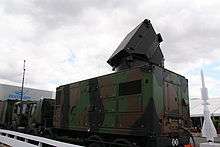
Aster 30 has been successfully incorporated into a land based SAM system, fulfilling the "Ground-based area defence" mission requirement. It comes in the form of the Eurosam SAMP/T (Surface-to-Air Missile Platform/Terrain). The system uses a network of sophisticated radars and sensors – including 3D phased array radar – enabling it to be highly effective against all types of air threats. SAMP/T uses an upgraded version of the Arabel long range radar, with improved performance developed under the Aster 30 block 1 upgrade program, in order to extend the system's capability against higher speed targets and higher altitude targets. The system can intercept missiles with a 600 km range (short range ballistic missile targets).[13]
Testing
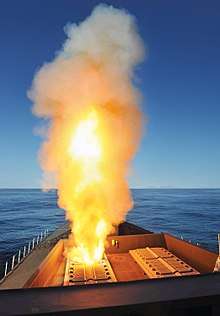
- In April 2008, RSS Intrepid, a Formidable class frigate of the Republic of Singapore Navy, shot down an aerial drone off the French port of Toulon during a naval exercise. Then again in 2010, a frigate of the same class, RSS Supreme fired an Aster 15 and shot down an aerial drone off the coast of Hawaii as part of exercise RIMPAC 2010.
- Beginning with HMS Dauntless in September 2010, all of the Royal Navy's Type 45 destroyers have successfully intercepted Mirach drones with Aster missiles at the Benbecula ranges off the Outer Hebrides, Scotland. Mirach is a 13 ft jet which flies at speeds of up to 600 mph (966 km/h) at altitudes as low as 10 ft (3 m) or as high as 14,000 ft (4 km).[14][15][16]
- In December 2011, an Aster 30 missile downed an Israeli Black Sparrow ballistic missile target, the first time an Aster missile had attempted such an engagement.[17]
- In April 2012, the Horizon-class frigate, Forbin, of the French Navy downed an American GQM-163 Coyote target simulating a sea-skimming supersonic anti-ship cruise missile traveling at Mach 2.5 (3000 km/h) with an altitude of less than 5 metres. It was the first time a European missile defence system destroyed a supersonic sea-skimming "missile". The trial was described as a "complex operational scenario".[6]
Operators
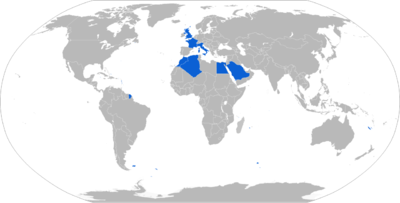
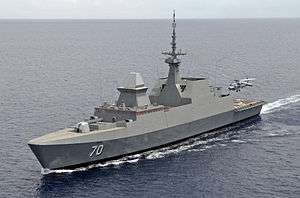
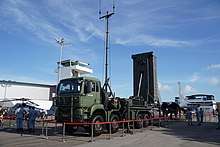
Current operators
Potential operators
See also
- PAAMS
- Anti-aircraft warfare
- Anti-ballistic missile
- Surface-to-air missile
- List of missiles
- CAMM (missile family)
- MIM-104 Patriot
- Type 3 Chū-SAM
- RIM-66 Standard
- RIM-67 Standard
- RIM-161 Standard Missile 3
- RIM-162 ESSM
- RIM-174 Standard ERAM
- S-300 (missile)
- S-400 (missile)
- S-500 (missile)
- HQ-9
- Barak 8
References
- MBDA - Aster PDF Archived 11 May 2012 at the Wayback Machine
- Eurosam: Naval Systems - Aster 15 & 30/PAAMS (Official Eurosam website), Retrieved February 2014. "Up to 120 km range"
- "Aster Anti-Air missiles" (pdf). Archived (PDF) from the original on 13 August 2020.
- "MBDA Press Release - 14 November 2006". MBDA. Retrieved 31 July 2016.
- "ASTER 15 & 30 - MBDA". mbda-systems.com. Retrieved 4 August 2016.
- "Interception d'une cible supersonique évoluant au ras de l'eau". defense.gouv.fr. French Ministry of Defence. 5 April 2012. Retrieved 31 July 2016.
- Eurosam - Program milestones Archived 28 March 2010 at the Wayback Machine
- Galati, Gaspare (2016). 100 Years of Radar. New York: Springer. pp. 234–235. ISBN 9783319005836.
- "Projet de loi de finances pour 2013 : Défense : équipement des forces" (in French). Senate of France. 22 November 2012. Retrieved 7 November 2013.
- "MBDA Press Information June 2014: The Aster Missile Family" (PDF). Archived from the original (PDF) on 30 March 2015. Retrieved 26 November 2015.
- ASTER - SAMP/T Archived 29 June 2012 at the Wayback Machine
- UK-France Summit: Annex on security and defence (PDF). gov.uk. 3 March 2016. Retrieved 5 August 2016.
- "Eurosam: Ground-launched systems". www.eurosam.com. Eurosam. Retrieved 5 August 2016.
- "HMS Daring fires Sea Viper for first time". gov.uk. Ministry of Defence. 19 May 2011. Retrieved 5 August 2016.
- "HMS Diamond fires Sea Viper missile for first time". gov.uk. Ministry of Defence. 1 May 2012. Retrieved 5 August 2016.
- "Defender ready to live up to her name after successful first Sea Viper firing". navynews.co.uk. Navy News. 16 May 2014. Archived from the original on 17 October 2017. Retrieved 5 August 2016.
- "Une première en France : un missile intercepté par un antimissile Aster". marianne.net. 1 December 2011. Retrieved 4 August 2016.
- Administrator. "Italian shipyard Fincantieri delivered amphibious ship Kalaat Beni-Abbes to Algerian Navy". navyrecognition.com. Archived from the original on 7 August 2016. Retrieved 4 August 2016.
- "DCNS Transfered [sic] the FREMM Frigate Tahya Misr to the Egyptian Navy". 24 June 2015.
- "16/06/2016". fincantieri.it. Retrieved 4 August 2016.
- Cabirol, Michel (31 May 2012). "DCNS propose la frégate Fremm et le Mistral au Canada" (in French). La Tribune. Retrieved 12 February 2015.
- Forrester, Charles (25 March 2019). "Bids in for Swiss air-defence programme, Rafael withdraws". Jane's 360. London. Archived from the original on 25 March 2019. Retrieved 25 March 2019.
- West’s reluctance to share tech pushes Turkey further into Russian orbitDefenseNews. Posted 10 January 2020.
- Turkey joins Italian-French consortium Eurosam for SAMP/T Aster 30 missile defense system DailySabah. Posted 14 July 2017.
External links
| Wikimedia Commons has media related to MBDA Aster. |